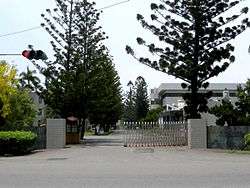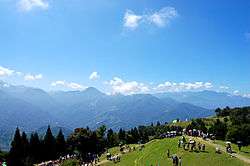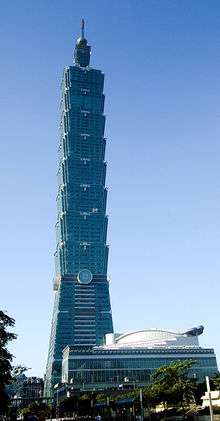Agriculture in Taiwan
Agriculture is one of the main industries in Taiwan. It contributes to the food security, rural development and conservation of Taiwan.[1] Around 24% of Taiwan's land is used for farming.[2]

History
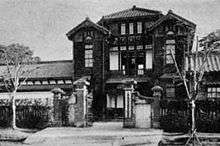
Prehistory
Agriculture has been an important sector of Taiwanese life since ages ago. From archaeological sites in Changbin Township, Taitung County, since Paleolithic Age around 30,000-50,000 years ago, people hunted, fished and gathered. Only in the Neolithic Age around 5,000-2,000 years ago, did people began to live their sedentary lifestyle where they grew rice and other crops and domesticated animals. During the Iron Age around 2,000 years ago, people in the northern coast of Taiwan began to make iron tools and food production increased significantly. In the 17th century, people from Mainland China began to migrate to Taiwan where they fished, hunted and grew crops. Most of them settled in Tainan.[3]
Dutch Formosa
During the Dutch Formosa in the early 17th century, the Dutch promoted the production of sugarcane and rice. At that time, 119 km2 of cultivated land in Taiwan belonged to the Dutch East India Company. The Dutch exported Taiwan's agricultural products and imported peas, tomatoes, wax apples and mangoes from Southeast Asia and United States to Taiwan.
Ming Dynasty
During the rule of Koxinga in the Kingdom of Tungning in the late 17th century, the number of immigrants from Mainland China to Taiwan increased to 200,000 people. This resulted in the increase of land under cultivation to 292 km2. Koxinga established a land tenure system and taught people to build reservoirs for irrigation. Rice was the main produce at that time. Mainland Chinese people also brought 43 kinds of vegetable from South China, such as leeks, garlic and Chinese cabbage.
Qing Dynasty
During the Qing Dynasty, immigration from Mainland China to Taiwan increased because of wars and famines in the mainland. People began to build canals for irrigation. At this time, the cultivated land in Taiwan increased to 3,506 km2 by 1895.
Empire of Japan
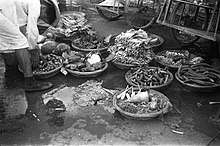
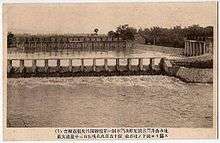
During the Empire of Japan, the Japanese greatly improved the agriculture sectors in Taiwan. They built concrete dams, reservoirs and aqueducts which forms an extensive irrigation system, such as the Chianan Irrigation. Arable land for rice and sugarcane productions increased by more than 74% and 30% respectively. They also established farmers' associations. Agriculture sector dominated the economy of Taiwan at that time. In 1904, 23% area of Taiwan was used as agricultural land.[4]
Republic of China
After the handover of Taiwan from Japan to the Republic of China in 1945, the government revitalized the agricultural sector first to recover from the damage caused by World War II and completed a full recovery by 1953. The government extended agricultural facilities and introduced the land reform program under the Sino-American Joint Commission on Rural Reconstruction. By 1956, agricultural land accounted for 34% of Taiwan's land use.[4]
In the late 1940s, Taiwan underwent high-speed economic growth and industrialization. In 1963, industrial sectors output value exceeded agricultural sectors output value. Also in the 1960s, the government shifted their priority to the development of export-oriented economic policy which focused on labor-intensive industries, such as textiles, convenience food and consumer electronics which eventually made Taiwan part of the Four Asian Tigers, along with British Hong Kong, Singapore and South Korea. However, this caused pressure on the agricultural sector as more and more people moved away from rural areas and labor costs increased.
In the 1970s, the role of agriculture shifted from the primary focus of the economy to a supporting role. The government at that time issued policies for farmers to grow organic crops. In the 1980s, much farmland was left idle due to the emigration of people from rural to urban areas as well as Taiwan beginning to open up to staple food imports. On 1 January 2002, Taiwan joined the World Trade Organization under the name Separate Customs Territory of Taiwan, Penghu, Kinmen and Matsu. This accession caused further damage to the agricultural sector in Taiwan. In response, the government has promoted agricultural tourism.[5]
Recently, the government has introduced new policy to reactivate all of the remaining idle farmland to ensure food security, food self-sufficiency and to revitalize the agriculture sectors. Policies to develop the sector to be more competitive, modern and green were also introduced.
In 2020 the Taiwanese government's Council of Agriculture set aside NT$5 billion (US$166.21 million) in loans for produce, livestock and aquaculture operations as well as other agriculture-based enterprises effected by the COVID-19 pandemic. The loans are at a preferential rate of 0.79 percent to 1.68 percent.[6]
Government
Agriculture-related affairs in Taiwan is handled by Council of Agriculture (COA), headed by Minister Chen Chih-ching, and its division Agriculture and Food Agency. Taiwan houses the headquarter of World Vegetable Center. Taiwan is also a member of world organizations related to agriculture, such as Afro-Asian Rural Development Organization, Asia-Pacific Economic Cooperation, International Commission for the Conservation of Atlantic Tunas and World Trade Organization.
Produce
In 2013, there are four main agricultural produce sectors in Taiwan, which are plant crops (47.88%), livestock (31.16%), fishery (20.87%) and forest (0.09%). The total annual agriculture produce production is around 6.9 million tons.[7]
Rice
In 2013, Taiwan harvested more than 1.6 million tons of rice yield from 2,703 km2 of land with a total value of NT$36.9 billion. It is the most valuable cash crop in Taiwan.[8] {{Citation needed|reason=Old citation is not valid.|date=May 2018}}
Betel nuts
In 2001, Taiwan harvested 165 thousand tonnes of betel nuts from more than 500 km2 of land, the second most valuable cash crop after rice.[9]
Cocoa
Taiwan's cocoa industry is centered in Pingtung in Southern Taiwan. Cocoa trees were first introduced to Taiwan during the Japanese colonial period. Because of high production costs and small farm size Taiwanese cocoa producers focus on producing estate-grade beans. The cocoa industry supports a significant domestic cocoa processing and chocolate making industry.[10]
Fruits
In 2013, Taiwan harvested 2.68 million tonnes of fruits from 1,844 km2 of land with a total value of US$191 million. Taiwan's fruit crops include banana, grape, guava, jujube, lychee, mandarin orange, mango, orange, papaya, pineapple, pomelo, sand pear, dragonfruit, starfruit, strawberry, watermelon and wax apple. The annual fruits export is 60,000 tons with a value of NT$3,452 million. The largest export market of Taiwanese fruits is Mainland China.[11]
Bananas are Taiwan's most important export fruit.[12] Guavas are a significant product with a little over half of exports going to Canada, in 2019 Taiwan received permission to export guavas to the United States for the first time.[13]
Viticulture and winemaking
Independent winemaking was illegal in Taiwan for a long time due to the monopoly granted to the Taiwan Tobacco and Liquor Corporation.[14] Taiwan Tobacco and Liquor Corporation produced just one wine, a rosé. With liberalization following the end of military rule independent winemakers became legal in 2002 and in 2014 a Taiwanese wine won its first gold medal at an international competition. The primary grapes cultivated for winemaking in Taiwan are Black Queen and Golden Muscat which were both introduced to the country in the 1950s.[15] A red wine from Taichung was awarded a gold medal at the 25th Vinalies Internationales in France.[16] Grape harvest in Taiwan is dictated by the typhoon season which means growers are sometimes forced to pick less than ripe fruit. Two of the most acclaimed wineries are Domaine Shu Sheng and Weightstone Vineyard Estate & Winery.[17] The relative rarity and high quality of Taiwanese wines makes them particularly prized by Hong Kong collectors.[14]
Vegetables
In 2013, Taiwan harvested 2.75 million tonnes of vegetables from 1,460 km2 of land with a total value of US$170 million. Major vegetables cultivated include broccoli, cabbage, carrot, chayote, Chinese cabbage, edamame, eggplant, kai-lan, onion, scallion and spinach. Vegetable plantation areas are mostly located in central and southern Taiwan. The peak harvest time is during the autumn and winter seasons.[18]
Tea

In 2013, Taiwan harvested about 15000 tons of tea with a total value of NT$6.92 billion, of which 3,919 tons was exported. Taiwan's tea produces are oolong tea, pouchong tea, green tea and black tea. Taiwan began cultivating tea around two hundred years ago.[19]
Flowers
In 2013, Taiwan harvested flowers with a total value of NT$16.52 billion, in which US$189.7 million of it was exported. Flower plantation land spreads over an area of 138 km2. Chrysanthemum floriculture takes the most land share among other types of flowers. Taiwan is the world's largest exporter of orchids, which represented 87% of the flower export value in 2013. The main export markets for Taiwanese flowers are the United States, Japan and the Netherlands.[20]
Livestock and poultry
In 2013, Taiwan produced livestock and poultry with a total value of NT$150 billion. Taiwan's major livestock are pigs, and the major poultry is chickens, both as broilers and eggs. Taiwan exported 10,890 tons of animal products and imported 295,063 tons.
Geese are a significant part of Taiwan's livestock and cuisine.[21]
Fisheries and aquaculture
In 2013, more than half of Taiwan's fishery products were exported with a total value of NT$54.5 billion. Taiwan's fisheries range from deep sea fisheries (43.64%), inland aquaculture (32.92%), offshore fisheries (12.48%), marine culture (6.93%) and coastal fisheries (4.03%). Taiwan's fishery products are clam, eel, grouper, milkfish, oyster and tilapia.
In 2013, Taiwan produced ornamental fishes with a total value of NT$1.2 billion. Taiwan has around 260 ornamental fish farms producing over 300 species of ornamental fish.
Most of the employees in Taiwan's fishing industries are the low-paid migrant workers from Indonesia, Philippines, Vietnam etc.
Economy
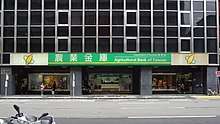
In 2013, agriculture sector contributes around 1.69% of its gross domestic product (GDP) with a total value of NT$475.90 billion.[22] Combined with agriculture-related tourism sector, it contributes to 11% of Taiwan's GDP. Taiwan exports around US$5 billion worth of agricultural products annually to Canada, Mainland China, Japan, Middle East Singapore and United States.
In 2013, agritourism in Taiwan attracted around 20 million visitors and generated NT$10 billion.
Manpower
The agriculture sector employs around 540,000 people in Taiwan, about 5% of the total population. In 1997, there were around 780,000 farm households, in which 80% of them were part-time farm households. There are 1.1 hectares of cultivatable land per farm family.[23]
Finance
Agricultural financing system consists of the Agricultural Bank of Taiwan (Chinese: 全國農業金庫) and credit departments of farmers' and fishermen's association which falls under the supervision of the Bureau of Agriculture Finance (Chinese: 農業金融局) of the COA. Agricultural Credit Guarantee Fund (Chinese: 農業信用保證基金) is responsible for financing farmers without enough collateral to acquire working capital.
Trade events
- Nantou Global Tea Expo (Chinese: 南投茶業博覽會)
Organizations
There are government-assisted farmer organizations around Taiwan which gives general assistance to farmers, such as supply, distribution, financial services etc. Farmer organizations in Taiwan consists of 302 farmers' associations, 40 fishermen's associations and 17 irrigation associations.
Politics
There is one political party in Taiwan related to agriculture or farmers which is the Taiwan Farmers' Party established on 15 June 2007. However, the party has no representative in the Legislative Yuan.
Research
There are 16 research institutes established under the COA aimed to the development and innovation of technologies in agriculture-related produce. In 2013, there are 123 agricultural technology transfers to the private sectors with royalty payment of around NT$84 million.
Technology
Spatial planning
Spatial planning for agricultural farms in Taiwan is embedded into the Taiwan Agriculture Land Information Service (Chinese: 臺灣農地資訊服務網) whose data is collected by Formosat-2 earth observation satellite. Information of farmland availability, soil properties, cropping suitability, irrigation infrastructures, land use zoning, and land consolidation are available for public access.
Security
In 2010, the food self-sufficiency of Taiwan was 32%.
Energy usage
In 2014, agriculture sector consumed a total 2,832.9 GWh of electricity.[24] Between 2000–2009, annual agricultural sector in Taiwan consumed 15.81 billion tons of water.[25]
Tourism
Over the past few years, agritourism has become more and more popular in Taiwan. The government has built recreational area around farms and fishing villages by integrating the produce, nature and festivals. In 2013, there are more than 75 recreation farming zones have been established and there are almost 317 recreational farms have been licensed. Food-related museums are also plenty in Taiwan.
Farms
Erjie Rice Barn, Flying Cow Ranch, Fushoushan Farm, Fuxing Barn, Jingzaijiao Tile-paved Salt Fields, Qingjing Farm, Rareseed Ranch, Shangri-La Leisure Farm, Shanlong Vegetable Park, Toucheng Leisure Farm, Tsou Ma Lai Farm and Wuling Farm.
Converted farmlands
Museums
Chihsing Tan Katsuo Museum, Coca-Cola Museum, Honey Museum, Kuo Yuan Ye Museum of Cake and Pastry, Ping Huang Coffee Museum, Ping-Lin Tea Museum, Soya-Mixed Meat Museum, Soy Sauce Brewing Museum, Spring Onion Culture Museum, Taiwan Mochi Museum, Taiwan Nougat Museum, Taiwan Salt Museum, Taiwan Sugar Museum, Teng Feng Fish Ball Museum, Wu Tao Chishang Lunch Box Cultural History Museum, Yilan Distillery Chia Chi Lan Wine Museum and Zhuzihu Ponlai Rice Foundation Seed Field Story House.
References
- "14670.pdf" (PDF). Archived from the original (PDF) on 2016-03-07. Retrieved 2016-03-03.
- "Agriculture - Taiwan - export, average, growth, crops, annual, farming".
- "National Museum of Natural Science -> Exhibition -> Permanent Exhibits -> Gallery of Agricultural Ecology".
- Chen, Yi-Ying; Huang, Wei; Wang, Wei-Hong; Juang, Jehn-Yih; Hong, Jing-Shan; Kato, Tomomichi; Luyssaert, Sebastiaan (2019). "Reconstructing Taiwan's land cover changes between 1904 and 2015 from historical maps and satellite images". Scientific Reports. 9 (1): 3643. Bibcode:2019NatSR...9.3643C. doi:10.1038/s41598-019-40063-1. PMC 6403323. PMID 30842476.
- Mansky, Jackie (30 September 2016). "Go Waist Deep Into the Largest Sunflower Farm in Northern Taiwan". Smithsonian. Retrieved 12 October 2016.
- Hui-ju, Chien; Chung, Jake. "Virus Outbreak: COA sets aside NT$5bn for farmer loans amid outbreak". www.taipeitimes.com. Taipei Times.
- "Taiwan's Agriculture - Overview". Agriculture and Food Agency, Council of Agriculture, Executive Yuan, R.O.C (Taiwan). January 1900. Retrieved 13 April 2018.
- "Agriculture - Taiwan Government Entry Point".
- CHENG, J. D.; LIN, J. P.; LU, S. Y.; HUANG, L. S.; WU, H. L. (2008). "Hydrological characteristics of betel nut plantations on slopelands in central Taiwan / Caractéristiques hydrologiques de plantations de noix de bétel sur des versants du centre Taïwan". Hydrological Sciences Journal. 53 (6): 1208–1220. doi:10.1623/hysj.53.6.1208.
- Su, Lynn. "A Sweet Vision: Taiwanese Chocolate's Road to the World". www.taiwan-panorama.com. Taiwan Panorama. Retrieved 10 December 2019.
- "Taiwan's Agriculture - Fruits". Agriculture and Food Agency, Council of Agriculture, Executive Yuan, R.O.C (Taiwan). January 1900. Retrieved 13 April 2018.
- "Taiwan Banana Research Institute" (PDF). www.banana.org.tw. TBRI. Retrieved 26 February 2020.
- and Joseph Yeh, Yang Shu-min. "Taiwan guavas to enter U.S. market". focustaiwan.tw. Focus Taiwan. Retrieved 3 January 2020.
- Whithead, Richard. "Tropical terroir made to produce award-winning wines". www.beveragedaily.com. Beverage Daily. Retrieved 5 May 2020.
- Cheung, Han (21 March 2020). "Vina Formosa comes of age". www.taipeitimes.com. Taipei Times. Retrieved 23 March 2020.
- Hui-ning, Hu. "Taichung red wine wins gold medal in France". www.taipeitimes.com. Taipei Times. Retrieved 30 April 2020.
- Huichen Chou, Cybil. "Why Hong Kong connoisseurs – and Michelin-star chefs – are taking note of Taiwan's wines". www.scmp.com. SCMP. Retrieved 30 April 2020.
- "Taiwan's Agriculture". Agriculture and Food Agency, Council of Agriculture, Executive Yuan, R.O.C (Taiwan). January 1900. Retrieved 13 April 2018.
- "Taiwan Tea Plantations". 8 March 2015.
- "Taiwan's Agriculture - Floriculture". Agriculture and Food Agency, Council of Agriculture, Executive Yuan, R.O.C (Taiwan). January 1900. Retrieved 13 April 2018.
- Hiufu Wong, Maggie. "40 of the best Taiwanese foods and drinks". edition.cnn.com. CNN. Retrieved 8 April 2020.
- "Agriculture". Government Portal of Republic of China, Taiwan. Archived from the original on 2016-03-07. Retrieved 2016-03-03.
- Super User. "2015 Taiwan's International Agricultural Machinery and Materials Exhibition - Show Introduction". Archived from the original on 2016-03-15.
- Bureau of Energy, Ministry of Economic Affairs (4 May 2012). "Energy Statistical annual Reports".
External links
| Wikimedia Commons has media related to Agriculture in Taiwan. |
| Wikisource has original text related to this article: |
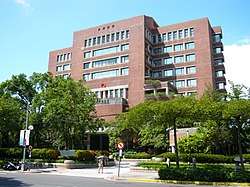
.jpg)
